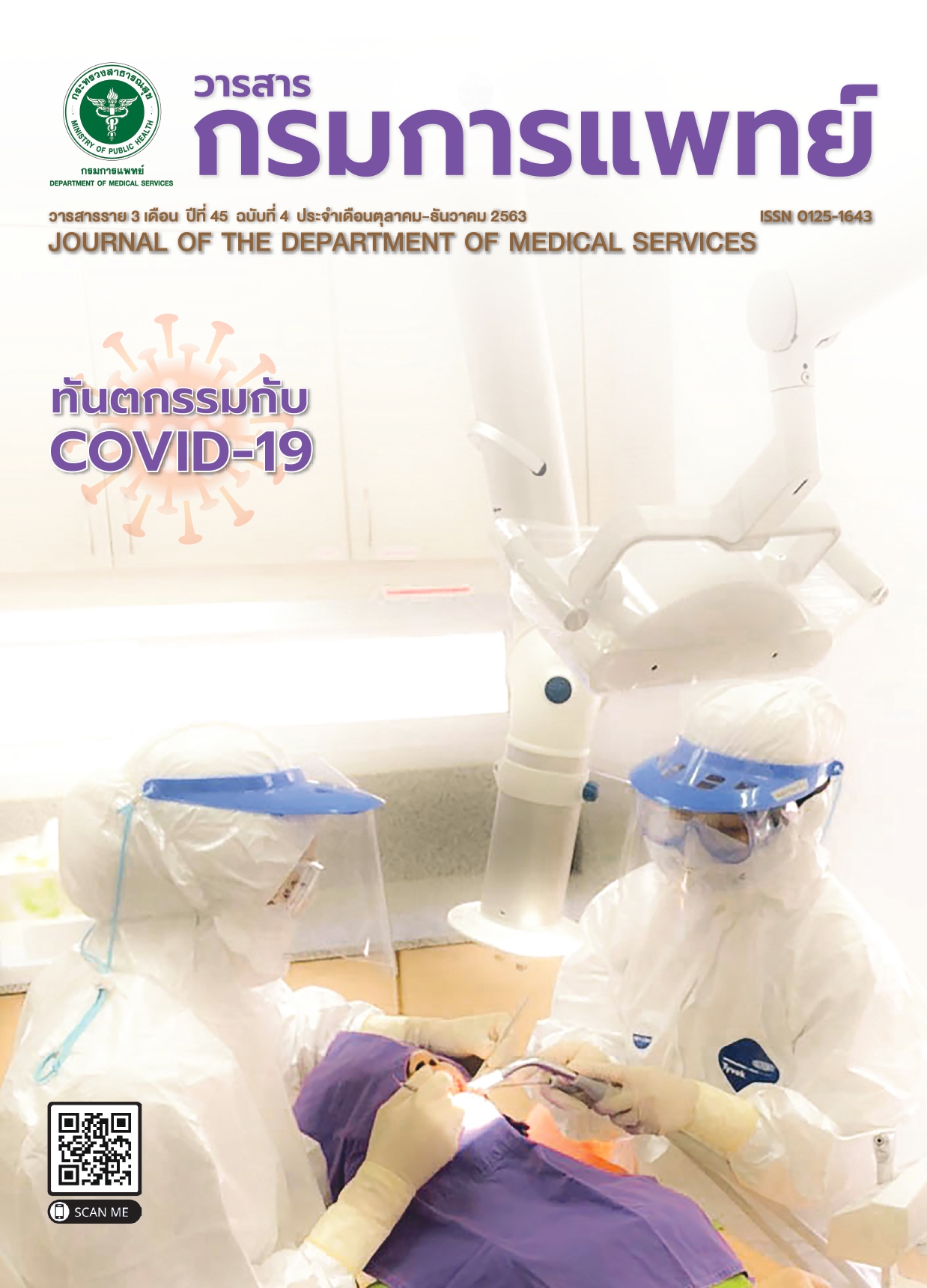The Epidemiology of Bloodstream infection (BSI) in Nopparat Rajathanee Hospital, 2018
Keywords:
HA-BSI rate, CA-BSI, Nopparat Rajathanee Hospital, POA definitionAbstract
Background : Blood stream infection; BSI is a major burden of health problems that contributed to high mortality. It can be classified into 2 types, community-acquired; CA-BSI and hospital-acquired; HA-BSI. Previous study presented the CA-BSI and HA-BSI definition which the duration time is several of them. CA- BSI was called present on admission; POA which followed US-CDC 2017 definition. POA is the patients who had length of stay less than 2 days. However, these patients may be readmitted, defined as ones who had length of stay more than 2 days of previous admission and discharged within 14 days before the date of event. Interestingly, the infection time frame of POA was not mentioned for HA-BSI.
Objective : To explore the BSI patients following US-CDC 2017 definition.
Method : Medical records of hospitalized patients during January to December 2018 who had at least one of positive blood cultures were review. Data was reviewed by infection control nurse team to identify blood culture results that were met the US-CDC 2017 definition for bloodstream infection.
Results : A total of 593 patients with at least one positive blood culture results were reviewed, 479 episodes (86.7%) were CA-BSIs, 97 episodes (16.4%) were HA-BSIs and 17 episodes (2.9 %) met POA. Primary BSI of POA was 58.8%, which the median (Q1, Q3) of the admission days before readmission were 7 (5, 16) days. The diagnoses of them from previous admission were urinary tract infections (23.5%) and pneumonia (17.6%) which the most of organisms were Escherichia coli (47.1%). Moreover, 62.5% of them found antimicrobial resistance bacteria.
Conclusions : Our study demonstrated that among patients who had bloodstream infections, 2.9% was POA. Most of these patients were readmitted within infectious diseases from previous admission. Our data may be beneficial for discharge planning for patient-at-risk. POA definition may be considered for these kinds of patients.
References
Hongsuwan M, Srisamang P, Kanoksil M, Luangasanatip N,Jatapai A, Day NP, et al. Increasing incidence of hospitalacquired and healthcare-associated bacteremia in northeast Thailand: a multicenter surveillance study.PloS one 2014;9:e109324.
Kanoksil M, Jatapai A, Peacock SJ, Limmathurotsakul D.Epidemiology, microbiology and mortality associated with community-acquired bacteremia in northeast Thailand: a multicenter surveillance study. PloS one 2013;8:e54714.
Grozdanovski K, Milenkovikj Z, Demiri I, Spasovska K,Cvetanovska M, Saveski V, et al. Epidemiology of community-acquired sepsis in adult patients: a six year observational study. PRILOZI 2018;39:59-66.
Baharoon S, Telmesani A, Tamim H, Alsafi E, Aljohani S,Mahmoud E, et al. Community- versus nosocomial-acquired severe sepsis and septic shock in patients admitted to a tertiary intensive care in Saudi Arabia, etiology and outcome.J Infect Public Health 2015;8:418-24.
Padro T, Smotherman C, Gautam S, Gerdik C, Gray-Eurom K, Guirgis FW. Admission characteristics predictive of inhospital death from hospital-acquired sepsis: a comparison to community-acquired sepsis. J Crit Care.2019;51:145-8.
Rudd KE, Johnson SC, Agesa KM, Shackelford KA, Tsoi D,Kievlan DR, et al. Global, regional, and national sepsis incidence and mortality, 1990-2017: analysis for the Global Burden of Disease Study. Lancet 2020;395:200-11.
Viscoli C. Bloodstream Infections: The peak of the iceberg.Virulence 2016;7:248-51.
Health Research & Educational Trust. Central Line-Associated Bloodstream Infections (CLABSI) Change Package:2017 Update. Chicago, IL: Health Research & Educational Trust. Accessed at www.hret-hiin.org
Centers for Disease Control and Prevention. National Healthcare Safety Network (NHSN) Patient Safety Component Manual 2017. [cited 2017 Oct 05]. Available from: https://www.cdc.gov/nhsn/pdfs/pscmanual/pcsmanual current.pdf.
Khumsri J, Tonkulrat W, Khuanped S, Wattanakul N, Aiumlaor P, Kiennukul N, et al. Bloodstream infection(BSI)surveillance in critical care units at Nopparatrajathanee Hospital, 2017.Journal of the department of medical service. 2018;44:132-6.
Infection Control Committee. Annal Report 2018 Surveillance for Healthcare Associated Infection. Nopparat rajathanee Hospital: The nursing of Infection prevention and control Department.
Rhodes J, Jorakate P, Makprasert S, Sangwichian O, Kaewpan A, Akarachotpong T, et al. Population-based bloodstream infection surveillance in rural Thailand, 2007–2014. BMC Public Health 2019;19:521.
Page DB, Donnelly JP, Wang HE. Community-, Healthcare-,and Hospital-Acquired Severe Sepsis Hospitalizations in the University HealthSystem Consortium. Crit Care Med 2015;43:1945-51.
Gruneir A, Dhalla IA, van Walraven C, Fischer HD, Camacho X, Rochon PA, et al. Unplanned readmissions after hospital discharge among patients identified as being at high risk for readmission using a validated predictive algorithm. Open Med2011;5:e104-11.
Aliyu S, Cohen B, Liu J, Larson E. Prevalence and risk factors for bloodstream infection present on hospital admission. J Infect Prev 2018;19:37-42.
Demographic statistics Population and Housing [Internet].Ministry of Digital Economy and Society. 2561[cited 2017 Oct 09]. Available from: http://statbbi.nso.go.th/staticreport/page/sector/th/01.aspx.
Infection Control Committee. Annal Report 2018 Surveillance for Healthcare Associated Infection. Nopparat Rajathanee Hospital: The nursing of Infection prevention and control Department.
Unahalekhaka A, Lueangapapong S, Chitreecheur J.Prevention of drug-resistant in the Intensive care unit 2014.[cited 2017 Oct 09]. Available from:http://kb.hsri.or.th /dspace/handle/11228/4265?locale-attribute=th.
Sante L, Aguirre-Jaime A, Miguel MA, Ramos MJ, Pedroso Y, Lecuona M. Epidemiological study of secondary bloodstream infections: The forgotten issue. J Infect Public Health 2019;12:37-42.
Sumetphimonchai W, Phrommun S, Curathong P. Urinary tract infection in adults. journal of the Nephology Society of Thailand 2011;17:5-15.
Downloads
Published
How to Cite
Issue
Section
License
บทความที่ได้รับการตีพิมพ์เป็นลิขสิทธิ์ของกรมการแพทย์ กระทรวงสาธารณสุข
ข้อความและข้อคิดเห็นต่างๆ เป็นของผู้เขียนบทความ ไม่ใช่ความเห็นของกองบรรณาธิการหรือของวารสารกรมการแพทย์



